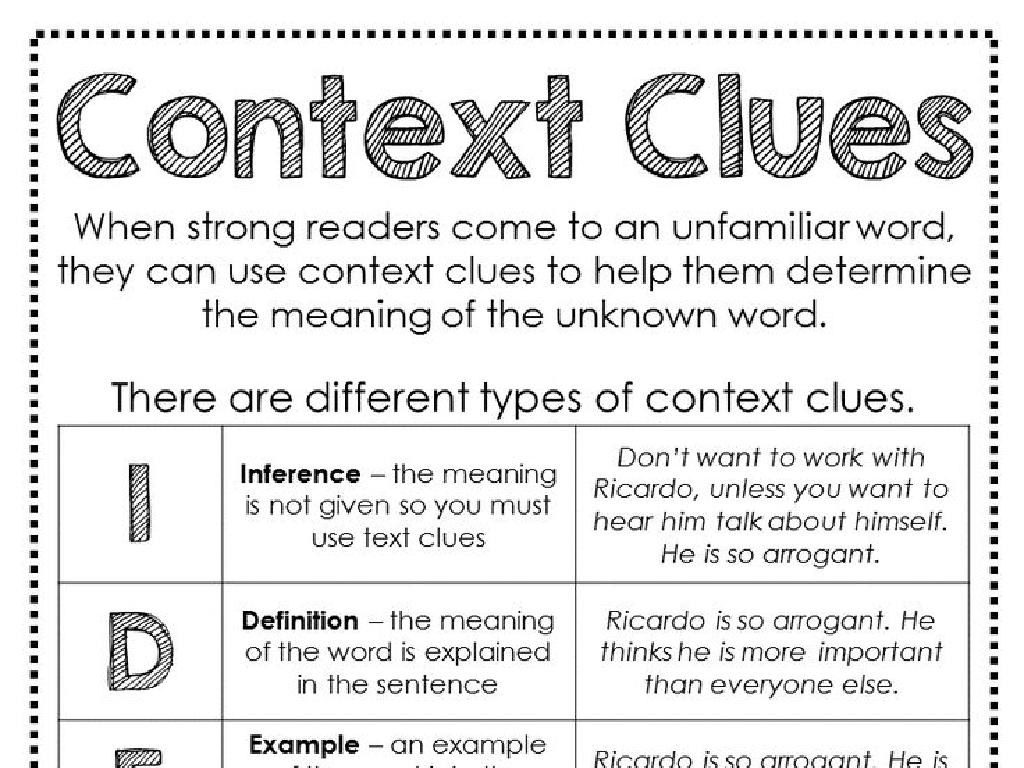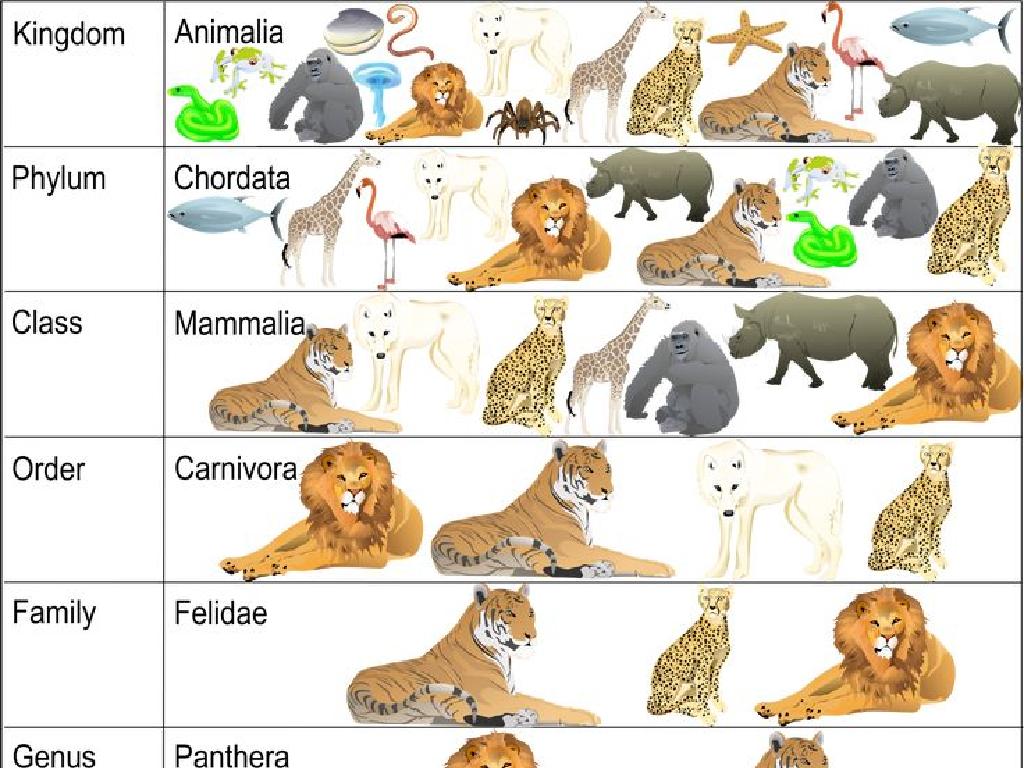Choose The Short I Or Long I Word That Matches The Picture
Subject: Language arts
Grade: Second grade
Topic: Short And Long Vowel Patterns
Please LOG IN to download the presentation. Access is available to registered users only.
View More Content
Welcome to Short and Long Vowels!
– Learn about short i and long i sounds
– Short i as in ‘fish’, long i as in ‘light’
– Vowel sounds aid reading and spelling
– Examples: ‘sit’ (short i) vs ‘site’ (long i)
– ‘bit’ (short i) vs ‘bite’ (long i), ‘pin’ (short i) vs ‘pine’ (long i)
– Practice matching words to pictures
– We’ll look at pictures and decide if the word uses a short i or long i
|
This slide introduces the concept of short and long vowel sounds, specifically focusing on the letter ‘i’. Understanding the difference between these sounds is crucial for developing reading and spelling skills in young learners. Start by explaining the concept of vowels and then demonstrate the short i sound as in ‘sit’ and the long i sound as in ‘site’. Provide clear examples and encourage students to mimic the sounds. Move on to interactive activities where students match words to pictures, reinforcing their understanding of short and long i sounds. For example, show a picture of a fish and a light, and have students choose the correct word that matches the picture. This will help them grasp the concept in a fun and engaging way.
Exploring Vowel Sounds: Short and Long ‘i’
– Vowels: Special alphabet letters
– Short vs. Long vowel sounds
– Short ‘i’ as in ‘fish’, Long ‘i’ as in ‘bike’
– Today’s focus: Letter ‘i’
– We’ll learn to distinguish ‘i’ sounds
– Practice with pictures
– Match words with images for understanding
|
This slide introduces the concept of vowels to second-grade students, emphasizing the difference between short and long vowel sounds. The focus is on the letter ‘i’, helping students to recognize and pronounce the short ‘i’ sound as in ‘sit’ and the long ‘i’ sound as in ‘like’. Use visual aids like pictures of a fish (short ‘i’) and a bike (long ‘i’) to illustrate the concept. Encourage students to practice by matching words to pictures, reinforcing their understanding of the ‘i’ sounds. This activity will prepare them for reading and spelling words with short and long ‘i’ sounds more accurately.
The Short i Sound
– ‘i’ as in ‘fish’ and ‘sit’
– Short i is heard in words like ‘fish’ where the i sounds quick and sharp
– Sounds like ‘ih’
– Imagine saying ‘ih’ as in ‘itch’ it’s a short, quick sound
– Practice saying ‘ih’
– Let’s say it together!
– We’ll all pronounce the short i sound in unison
|
This slide introduces the short i sound to second graders, helping them recognize and pronounce it correctly. Start by explaining that the short i sound is a common vowel sound in English, and it’s important to be able to identify it in words. Use familiar examples like ‘fish’ and ‘sit’ to illustrate the sound. Encourage the students to listen and repeat the sound after you, ensuring they understand the difference between the short ‘ih’ sound and other vowel sounds. Engage the class by having them say the sound in unison, and correct any mispronunciations individually. This interactive approach helps solidify their understanding of short vowel sounds.
The Long i Sound
– ‘i’ in ‘bike’ says long i
– Long i sounds like ‘ai’
– Practice saying long i
– Try words like ‘kite’ and ‘smile’
– Let’s repeat the sounds together
– I’ll say it, then you say it!
|
This slide introduces the long i sound to second graders, helping them recognize and pronounce it correctly. Start by explaining that the long i sound is the same as the ‘i’ in ‘bike’ or ‘like’, and it sounds similar to ‘ai’. Encourage the students to listen as you pronounce the long i sound, and then have them repeat it back to you. Use words that they are familiar with, such as ‘kite’ and ‘smile’, to practice the sound. Make this interactive by saying a word with the long i sound and then having the students repeat it. This will help them become more comfortable with the pronunciation and recognition of the long i sound in different words.
Matching Game: Short i or Long i?
– Observe the picture closely
– Choose the word that matches
– Decide: short i or long i sound?
– Is it ‘fish’ (short i) or ‘bike’ (long i)?
– Let’s practice as a class!
– We’ll do a few examples together first.
|
This slide is designed to engage second-grade students in a fun matching game to differentiate between short i and long i sounds. Start by showing a picture and asking students to observe it carefully. Then, present two words, one with a short i sound and one with a long i sound, and ask the students to choose the word that matches the picture. Encourage them to articulate whether the word they choose has a short i or a long i sound. Begin with a few practice rounds as a class to ensure understanding. As you progress, provide immediate feedback and reinforcement to help solidify their learning. This activity will help students with phonemic awareness and improve their ability to decode words based on vowel sounds.
Practice Time: Short i or Long i
– Look at each picture carefully
– Think: Is it a short i or long i sound?
– Short i as in ‘fish’, long i as in ‘bike’
– Choose the word that matches the picture
– Is it ‘sit’ or ‘site’? Choose the right one
– Say the word out loud
– Practice pronunciation with your classmates
|
This slide is for a classroom activity where students will practice distinguishing between short i and long i sounds in words. Display a picture and have the students look at it carefully. Ask them to think about whether the word that represents the picture contains a short i sound, like in ‘fish’, or a long i sound, like in ‘bike’. Then, they should choose the correct word that matches the picture. Encourage them to say the word out loud to practice their pronunciation. This activity will help reinforce their understanding of short and long vowel patterns. For the teacher: Prepare a set of pictures that can be associated with words containing short i and long i sounds. Make sure to have a diverse set of examples and encourage participation from all students.
Review: Short i and Long i Sounds
– What is the short i sound?
– Example of short i
– ‘Fish’ has a short i sound, like in ‘sit’
– What is the long i sound?
– Example of long i
– ‘Bike’ has a long i sound, similar to ‘like’
|
This slide is meant to review the concepts of short i and long i vowel sounds. Start by asking students to recall what the short i sound is and provide an example. The short i sound is typically found in words like ‘sit’ and ‘fish’ where the vowel is pronounced quickly and sharply. Then, move on to the long i sound, which is pronounced like the name of the letter ‘I’ itself, and can be heard in words like ‘like’ and ‘bike’. Encourage students to come up with their own examples and to listen for the difference in sounds. This will help them in identifying and using the correct vowel sounds when reading and writing.
Class Activity: Vowel Sound Hunt
– Search for short i and long i words
– Explore the classroom or your book
– Pair up and list your findings
– Work together and help each other
– Share your list with the class
– Discuss how you decided on the vowel sounds
|
This activity is designed to engage students in a practical search for words containing the short i and long i sounds. Encourage them to look at posters, labels, and books within the classroom. They should work in pairs to foster collaboration and discussion about the sounds they find. Each pair will make a list of the words they discover, noting which have the short i sound (like in ‘fish’) and which have the long i sound (like in ‘like’). After the hunt, pairs will share their lists with the class, and you can facilitate a discussion on how they determined the vowel sounds in each word. This will help reinforce their understanding of short and long vowel patterns in a fun and interactive way.
Mastering Short i and Long i Sounds
– Congratulations on learning short i and long i!
– Listen for these sounds in words as you read.
– Practice makes perfect with vowels.
– Try reading out loud to hear the vowel sounds clearly.
– You’re on your way to becoming vowel experts!
– Keep identifying short i and long i in different words.
|
This slide is meant to wrap up the lesson on short i and long i vowel sounds. It’s important to praise the students for their hard work and encourage them to continue practicing. Remind them to pay attention to the sounds of vowels when they read, which will help them become more proficient in recognizing and using short i and long i sounds. Provide some tips for practicing, such as reading aloud and listening to the sounds they make. You can also suggest playing word games that focus on vowel sounds or having them write down new words they come across with short i and long i sounds.






